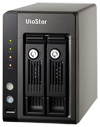 Storage of IP surveillance video is driven by cost and, based on your application, how long you need to store the video.
Storage of IP surveillance video is driven by cost and, based on your application, how long you need to store the video.
High quality, high resolution IP surveillance video can take up a lot of space and can be a sizable cost of your IP surveillance system. But with today’s technology, driven by Moore’s Law (“The number of transistors incorporated in a chip will approximately double every 24 months.”), any size of storage system that you need can be arranged.
That is to say video frame rate, number of cameras, and video retention time can be handled. IP video surveillance storage systems have varying degrees of performance, cost, and scalability.
On-Board Storage
For remote locations or an application that only uses a few cameras, storing the video on-board in the IP camera’s memory may make sense. For example, video could be stored locally in the camera and then transferred over a network or, the internet to a more central location.
IP cameras have at least some RAM that can be used to store video but some also come with slots for:
- SD Cards: Secure Digital cards are removable memory capable of storing gigabytes worth of data.
- USB Flash Drives: USB (universal serial bus) flash drives or, thumb drives, are also portable, removable memory sources that are capable of storing multiple gigabytes worth of data. Depending on the size of the USB drive this could be hours or days of video storage.
Single Server Storage
Single server storage is a common solution for IP video storage in small and medium sized installations of up to 50 or so IP cameras. The hard disk is located in the same PC that runs the video management software.
The PC size determines how many hard disks can be used and therefore the storage space that is available. It’s possible to get up to several terabytes worth of space.
When this space runs out, separate systems such as NAS (network attached storage) and SAN (storage area network) can be added to complement your storage system.
NAS – Network Attached Storage
NAS is a single storage device that is directly attached to your LAN (local area network) and offers shared storage to all users on your network.
NAS devices are generally:
- Simple to install
- Easy to administer
- A low-cost solution
SAN – Storage Area Network
An SAN is a high-speed special purpose network for storage devices. Users access any of the storage devices on the SAN through the servers and the storage is scalable to hundreds of terabytes or even petabytes (1,000 TB).
SAN’s are a centralized storage system for use in multi-server environments that:
- Reduce administration
- Provide flexibility
- Act as a high performance storage pool
NAS vs SAN
For more on these types of storage systems, check out these sites that compare the two side by side:
- NAS – SAN Comparison
- SAN vs NAS – What Is the Difference?
- NAS vs. SAN Network Storage – Networking Computer Tips
RAID System
RAID is Redundant Array of Independent Drives that is the method of arranging standard off-the-shelf hard drives in such a way that your operating systems views them all as one large, solitary hard disk. This is done to:
- Increase performance
- Reduce issues
- Ensure video storage system’s reliability
RAID systems make sure that no recorded surveillance video is lost if one of your hard disks fails.
Best Practices
Up next I’ll review some of the best practices you’ll want to consider when setting up a storage system for your IP video surveillance.

Pingback: IP Video Surveillance Storage - Best Practices — IP Camera Supply Blog
Pingback: IP Video Storage - RAID — IP Camera Supply Blog
Pingback: Connellymailbox » Blog Archive » Important Tips About Security & Surveillance Systems